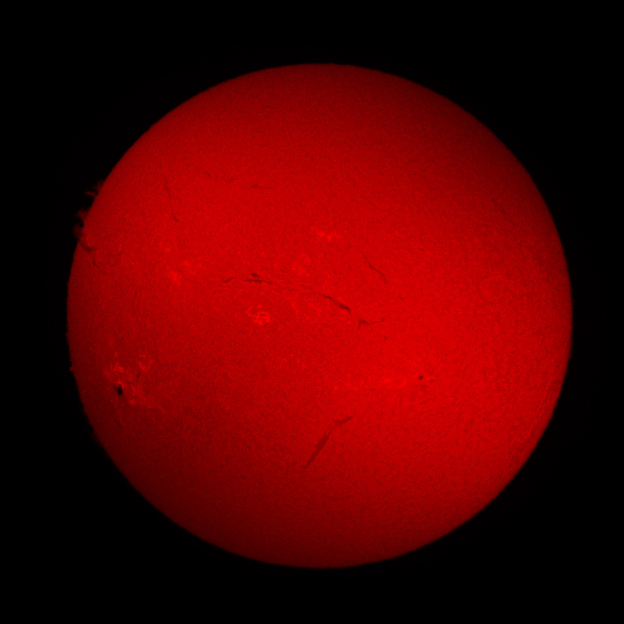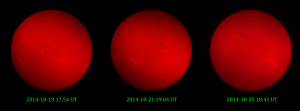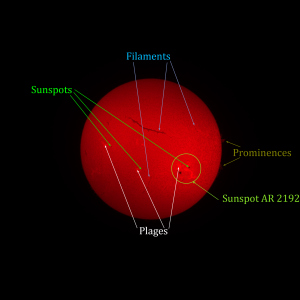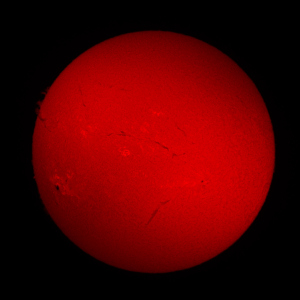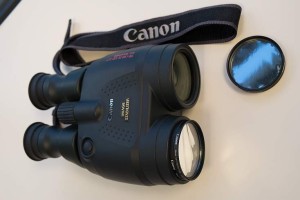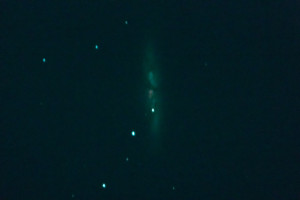On Thursday last week the largest sunspot seen in over 20 years rotated off the face of the Sun. I managed to snag quite a few images of it, and I thought I’d make a post describing just how interesting this particular spot was.
First let’s look at how the Sun rotates. I have three images spanning 6 days. The quality of the images is pretty variable because I don’t really know what I’m doing.
The European Space Agency and National Aeronautics and Space Administration have developed a tool called JHelioViewer that let’s individuals create movies from Solar Dynamics Observatory and Solar and Heliospheric Observatory data. It don’t see any hydrogen-alpha (656.28 nm) data, but the helium II (30.4 nm) data from SDO looks similar enough. The data is colored red, but 30.4nm light is actually in the far ultra-violet part of the spectrum. I made a low-res movie that covers the time period that AR 2192 was visible. All the movies for this post span the period 2014-10-19 0 UT to 2014-10-30 0 UT.
There are quite a few different wavelengths of light to choose from when using JHelioViewer. It’s interesting to see what the sunspot looks like in different wavelengths. At 160.0 nm (below) and 170.0 nm (further below), bright flashes around the sunspot look like lightning flashes in a thunderstorm here on Earth. Both of these wavelengths are also in the ultraviolet, and, thus, they are not visible to the human eye. If you keep an eye on the sunspot you can see it changing shape over time. Another thing to notice while you watch the videos is the rotation rate of the sun. You can see how the rotation at the poles is slower than the rotation at the solar equator.
Finally a great view of just the sunspots can be had at 450.0 nm. This light would be violet or blue to the eye. (Don’t ask me why they didn’t color it as it would be seen by the eye.)
These movies really show what a dynamic object the Sun is, and why it makes such a great object for amateurs. Because of the distance to most objects and the limited resolution available (due to the size of amateur instruments and the atmosphere), the objects we view normally appear static with the exception of the Sun, Jupiter, Saturn, and the inner planets. Of course, to look at the Sun without damaging your eyes or your equipment, you need a solar filter, but Baader solar film for viewing in white light is quite affordable while glass white light filters are moderately more expensive.
Here is a diagram to illustrate the features of interest in the photos.
OK. Now lets take a look at the scale of what was going on on the Sun because it’s truly mind boggling.
The large sunspot within AR 2192 is 21,000-25,000 km in diameter in this image. For perspective, the Earth is 12,742 km in diameter. So that big black dot is roughly twice the diameter of the Earth.
The amount of turbulence on the Sun associated with the area around AR 2192 is staggering. If you look at my photo from 2014-10-12 in an earlier post, then you can see a more normal surface texture of the sun. In the photos with AR 2192, the surface in a region about 750,000 km in diameter is completely disturbed. The huge plage running through AR 2192 is about 225,000 km long.
Earlier this year we had another big spot that survived over a half rotation, so there’s a chance that this spot will reappear when it rotates back into our view near the end of November. It should be interesting.
Here are the two best images without any annotations.
